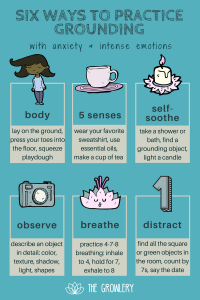
http://hhri-gbv-manual.org/about/tools/grounding
The following exercises were retried from the link above:
Grounding exercises
Grounding is an important therapeutic approach for handling dissociation or flashbacks, and reducing the symptoms of anxiety and panic. It is important to practice the exercises again and again until the skill becomes automatic and can be called on even during moments of distress. The aim of grounding is to take the survivor out of whatever traumatic moment she is remembering.
1. Grounding the body. (10-15 minutes.)
This exercise can help a survivor to come down from hyperarousal and find a more balanced emotional state. It can also be used to focus survivors who are in ‘freeze-mode’.
Sit on your chair. Feel your feet touching the ground. Stamp your left foot into the ground, then your right. Do it slowly: left, right, left. Do this several times. Feel your thighs and buttocks in contact with the seat of your chair (5 seconds). Notice if your legs and buttocks now feel more present or less present than when you started focusing on your legs.
Now move your focus to your spine. Feel your spine as your midline. Slowly lengthen your spine and notice if it affects your breath (10 seconds). Move your focus toward your hands and arms. Put your hands together. Do it in a way that feels comfortable for you. Push your hands together and feel your strength and temperature. Release and pause, then push your hands together again. Release and rest your arms.
Now move your focus to your eyes. Look around the room. Find something that tells you that you are here. Remind yourself that you are here, now, and that you are safe. Notice how this exercise affects your breathing, your presence, your mood, and your strength.
Source: Jacobson, Edmund. 1974. Progressive Relaxation. Chicago: The University of Chicago Press, Midway Reprint.
2. The Hug. (5-8 minutes.)
This exercise deepens and anchors positive feelings and messages. It is taken from EMDR (Eye movement desensitisation reprocessing), a trauma processing method. The method employs bilateral physical stimulation (in this case tapping), which, combined with positive spoken messages, is said to deepen and anchor positive feelings. The sentence can also be spoken silently.
Put your right hand palm down on your left shoulder. Put your left hand palm down on your right shoulder. Choose a sentence that will strengthen you. For example: “I’m a good enough helper”. Say the sentence out loud first and pat your right hand on your left shoulder, then your left hand on your right shoulder.
Alternate the patting. Do ten pats altogether, five on each side, each time repeating your sentences aloud.
3. Progressive release of muscular tension. (15 minutes.)
This exercise calms a survivor who is agitated.
Whenever you become anxious, your body tenses. This can generate symptoms of pain in the shoulders, neck or back, or tension in the jaw, arms or legs. To train yourself to progressively release this tension, start by intentionally tensing specific groups of muscles, and relaxing them.
Focus on the difference of feeling between the tense and relaxed state of the muscles. Practise on different parts of the body: the head, face, neck, shoulder, back, stomach, buttocks, arms, hands, legs or feet. Increase tension and hold it for 5 seconds; then release and hold for 10 seconds. Find the tempo that suits you. Increase the tension and release the tension ten times in each muscle group, with a short pause in between.
- Start by focusing on your hands. Make a fist, hold it for 5 seconds, release for 10. Notice the difference between the tense and released states. Do it once more.
- Move the focus to your arms. Pull your forearms towards your shoulder. Feel the tension in your upper arms. Hold for 5 seconds, release for 10. Notice the difference, Do it once more.
- Stretch your arm out, and lock the elbow. Feel the tension in the triceps. Hold for 5 seconds, release for 10. Notice the difference. Repeat. When your arms are relaxed, let them rest in your lap.
- Focus on your face. Increase the tension in your forehead, lift your eyebrows. Notice the tension. Hold for 5 seconds, release for 10. Notice the difference. Repeat.
- Increase the tension in your jaw. Hold. Release. Repeat.
- Focus on the muscles in your neck. Bend your neck so that your chin touches your chest, turn your head slowly to the left, bring it back to the centre, bend it back, bring it back to the centre, turn it to the right, bring it back to the centre. Repeat slowly since there is often a lot of tension in this area.
- Focus on your shoulders. Lift them. Hold and notice the tension. Release. Notice the difference. Repeat.
- Focus on the shoulder blades. Pull them back. Increase the tension. Relax. Notice the difference and repeat.
- Stretch your back by sitting in a very upright position. Hold the tension and relax, notice the difference and repeat.
- Increase the tension in your buttocks. Hold for 5 seconds and release, notice the difference, repeat.
- Hold your breath. Pull your stomach in, tighten it, and relax. Notice the difference, repeat.
- Focus on your legs. Stretch them out, feel the tension in your thighs, hold and relax.
- Straighten your legs again; this time make your toes point towards you. Notice the tension in the back of your legs, and the feeling of relaxation when you release. Repeat.
- Focus on your toes, make them point downwards as far as you can. Feel the tension and release.
- Scan your whole body. Does any part still feel tense? Repeat the exercise for this part.
- Imagine that a relaxed feeling is spreading through your whole body. Your body feels warm, perhaps a little heavier, relaxed.
4. Creating a safe place. (10-12 minutes.)
This exercise helps survivors who are in “freeze-mode”, feeling numbed and frozen. Make yourself comfortable, with your feet on the ground. Feel and relax your body, your head, your face, your arms, spine, stomach, buttocks, thighs, legs. Choose whether you want to close your eyes or keep them open during this exercise. Listen carefully to the Trainer’s voice.
• Think of a place in which in the past you were calm and confident and safe. It may be outdoors, at home, or somewhere else. It can be a place to which you have been once or many times, which you saw in a film or heard about, or imagine. You can be there by yourself or with someone you know. It can be private, unknown to others, somewhere that no one can find without your permission. Or you can decide to share it with others.
This place must suit you and meet your needs. You can constantly recreate or adapt it. It is comfortable and richly equipped for all your wants. Everything you need to be comfortable is present. It is somewhere that fits you.
It shuts out every stimulus that might be overwhelming.
• Imagine this place. Imagine you are there. Take time to absorb it in detail: its colours, shapes, smells and sound. Imagine sunshine, feel the wind and the temperature. Notice how it feels to stand, sit or lie there, how your skin and your body feel in contact with it.
• How does your body feel when everyone is safe, and everything is fine? In your safe place you can see, hear, smell and feel exactly what you need to feel safe. Perhaps you take off your shoes and feel what it is like to walk barefoot in the grass or in the sand.
• You can go to this place whenever you want and as often as you want. Just thinking about it will cause you to feel calmer and more confident.
• Remain there for five more seconds. Then prepare to return to this room, open your eyes, stretch yourself, do what you need to return to the present.
5. Re-orienting to the present. (10 minutes.)
This exercise is of help to survivors in ‘freeze-mode’, who feel numbed and frozen.
Form pairs and sit together. One of the pair should play a helper and the other a survivor. The Helper should assist the Survivor to use her senses to put herself fully in the present and feel safe.
Take turns.
- Look round you and name 3 things you see.
- Look at something (an object, a colour, etc.)
Tell yourself what you are seeing.
Name 3 things you hear.
- Listen to a sound (music, voices, other sounds).
- Tell yourself what you are hearing.
Name 3 things you touch.
- Touch something (different textures, different objects).
- Tell yourself what you are touching.
Now, notice your state of mind.
- Do you feel that you are more present in the room or less present after doing the exercise?
- Do you feel calmer or more energised?
6. ‘Squeeze-hug’. (5 minutes.)
This exercise calms survivors who are agitated. It can also help ‘frozen’ survivors to concentrate on the here-and-now.
Cross your arms in front of you and draw them towards your chest. With your right hand, hold your left upper arm. With your left hand, hold your right upper arm. Squeeze gently, and pull your arms inwards. Hold the squeeze for a little while. Find the right amount of squeeze for you right now. Hold the tension and release. Then squeeze for a little while again and release. Stay like that for a moment.
7. Feeling the weight of your body. (5 minutes.)
This exercise helps survivors who are ‘frozen’ or numb to focus on the present.
The exercise activates muscles in the torso and legs, which gives a feeling of physical structure. When we are overwhelmed, our muscles often change from extreme tension to collapse; they shift from a state of active defence (fight and flight) to submission and become more than ordinarily relaxed (hypotonic). When we are in touch with our strength and structure, it is easier to bear feelings. We can contain our experience and manage feelings of fragmentation (of being overwhelmed) better.
- Feel your feet on the ground. Pause for five seconds.
- Feel the weight of your legs. Hold for five seconds.
- Try stamping your feet carefully and slowly from left to right, left, right, left, right. Feel your buttocks and thighs touching the seat of the chair. Hold that for five seconds.
- Feel your back against the back of the chair.
- Stay like that and notice if you feel any difference.
8. Straightening the back. (15 minutes.)
This exercise increases a survivor’s awareness that the ‘state of her body’ depends on her ‘state of mind’.
We carry ourselves with our spines. We can react to danger by collapsing the spine, and this affects our posture. By changing our posture, we give ourselves new strength and can more easily contain and manage our experiences. We give ourselves a stronger back and reconnect with our bodily resources.
• Collapse your chest and back. Notice how it feels. Pause. How does it affect your breathing? Pause again. Be aware of your feelings and mood. Pause. Be aware of your body. Pause. Be aware of your thoughts. Now say: “I am happy!” Say again: “I am happy!” Do you feel happy? Does it feel right to say you are happy?
• Now slowly lengthen your spine until you are comfortable. Adjust and experiment until your spine feels aligned and naturally lengthened. Be aware how you feel now. Be aware of your breathing. Pause for five seconds. Be aware of your feelings and mood. Pause. Be aware of your body. Pause. Be aware of your thoughts. Pause. Now say: “I am sad!” Say several times. “I am sad!” Do you feel sad? Does it feel right to say that you are sad?
9. Square-breathing. (4 minutes.)
Sit comfortably. Lower your shoulders.
• Look at a square form, or visualise one with your eyes closed.
• Breathe in while counting to 4. Let your eyes wander up the left side of the square.
• Hold your breath while counting to 4. Let your eyes run across the top of the square.
• Breathe out while counting to 4. Let your eyes run down the right side of the square.
• Hold your breath while counting to 4. Let your eyes run along the bottom of the square.
Repeat 4 times.
10. Breath counting. (4 minutes.)
Sit in a comfortable position with the spine straight and the head inclined slightly forward. Gently close your eyes and take a few deep breaths.
- To begin the exercise, count “one” to yourself as you exhale.
- The next time you exhale, count “two,” and so on up to “five”.
- Then begin a new cycle, counting “one” on the next exhalation.
Repeat 5 times.
Never count higher than five, and count only when you exhale. You will know your attention has wandered when you find yourself counting up to eight, twelve, etc.






Leave A Comment
You must be logged in to post a comment.